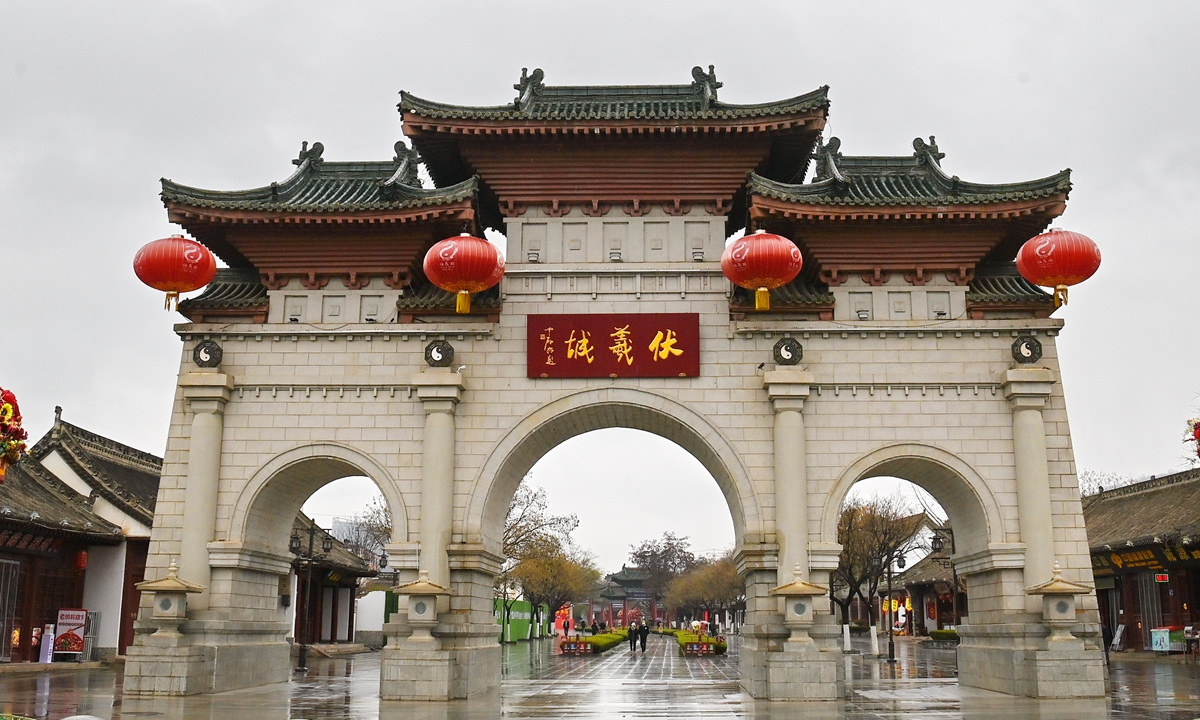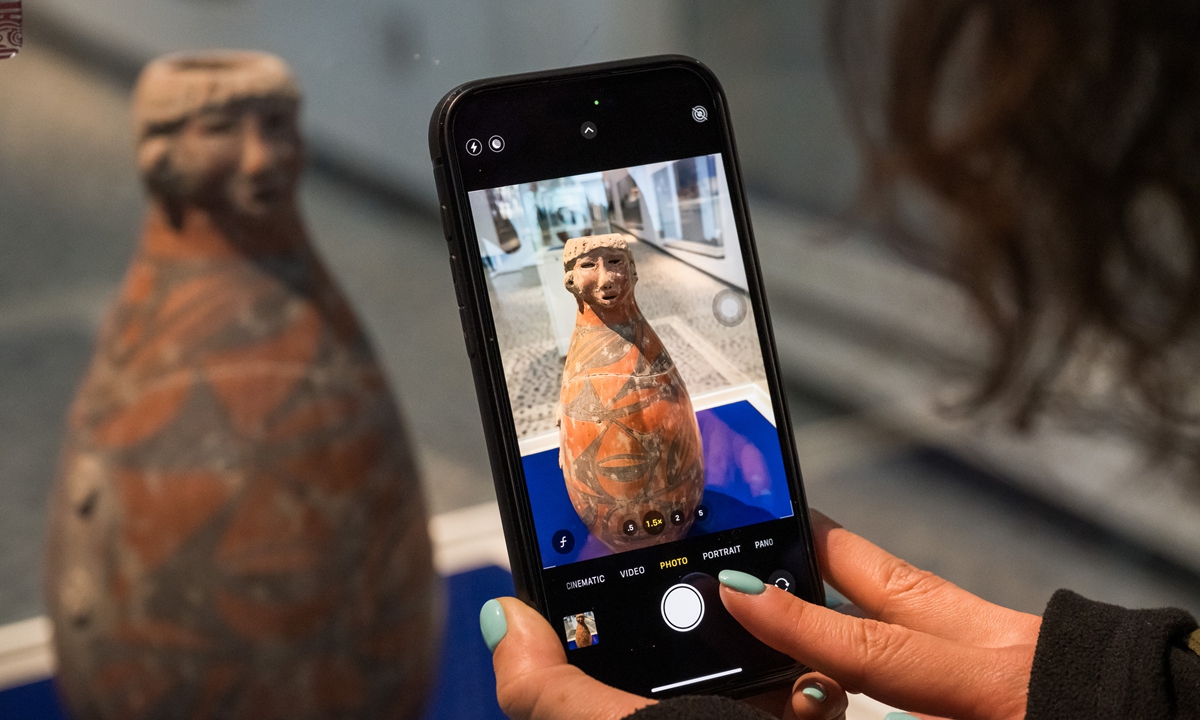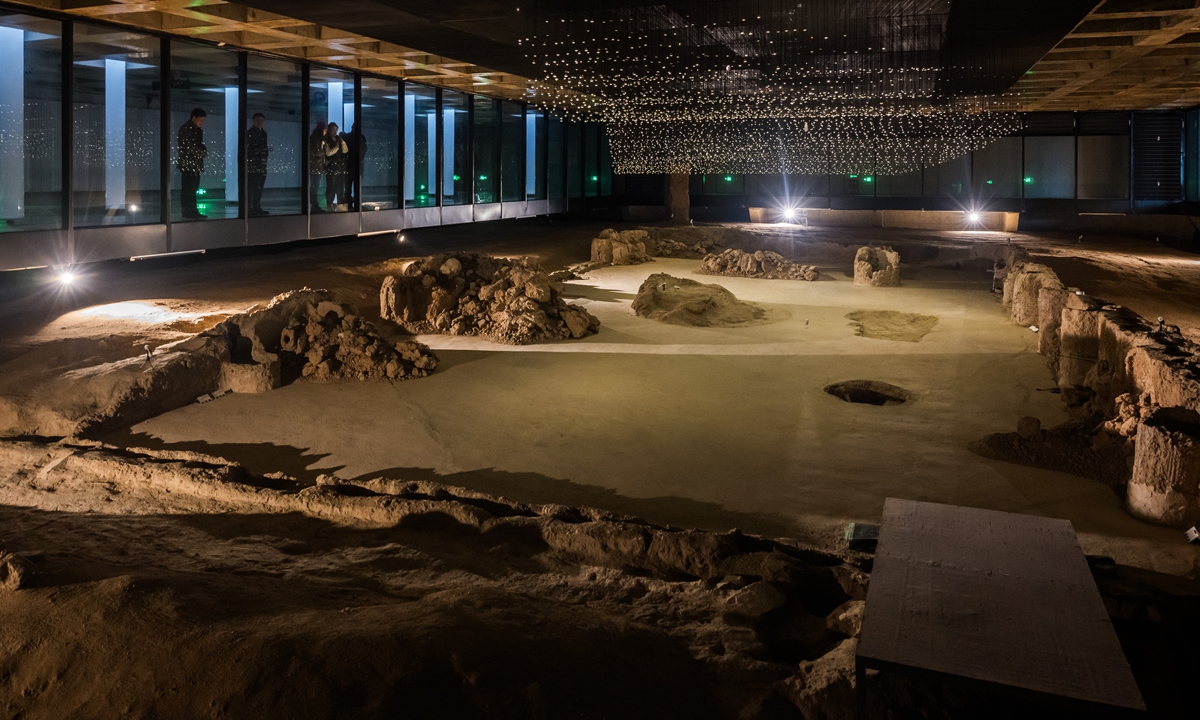ARTS / ART
Archaeological stories about legendary Fuxi uncover creativity in early Chinese civilization
More than myths

The gate of Fuxi town in Tianshui, Northwest China's Gansu Province Photo: VCG
Just as Adam and Eve are commonly recognized in Western mythology as the "first man and woman," Fuxi and Nüwa are also similar mythological counterparts in Chinese tradition, especially Fuxi, who is praised as the Creator of the Chinese nation.
Tianshui, a city in Northwest China's Gansu Province is historically known as the birthplace of Fuxi. It boasts a Ming Dynasty (1368-1644) architectural complex that is called the Temple of Fuxi.
In June every year, a grand sacrificial ceremony is held in Tianshui to commemorate the legendary character that has continued to inspire generations of Chinese people for 7,000 years.

A visitor takes a photo of the pottery excavated in Tianshui. Photo: Chen Tao/GT
'Living proof'Aside from the main statue of Fuxi, the Temple of Fuxi has an exhibiting wall displaying his numerous ancient creations. It was said that he created the Bagua, also known as the Eight Diagrams.
The Eight Diagrams refer to a set of patterns designed to inform nature's changes and regulations.
Prior to its connection to Taoist metaphysics, Fuxi first invented the Eight Diagrams to identify the 24 solar terms.
A guide surnamed Yang at the site told the Global Times that Fuxi was widely praised due to his "agricultural wisdom."
Apart from the Eight Diagrams design, Fuxi also invented nets for fishing, and was also a pioneer in the construction of pens for livestock.
Many of his agricultural inventions were recorded in ancient books such as the Sanhuang Benji written by Sima Zhen in the Tang Dynasty (618-907).
Fuxi, along with his inventions does not just live in people's imagination.
Located in Tianshui's Qin'an county, the Dadiwan archaeological site is "living proof" of Fuxi's footprints since many of his inventions were found to have been used by Neolithic Age people as "a guide to daily life," Shao Yaofeng, director of Gansu Provincial Institute of Cultural Relics and Archaeology, told the Global Times.
Dating back to around 8,000 years ago, the Dadiwan site is a Neolithic Age ruin, at which China's earliest sorghum was discovered. The site encompasses five cultural periods between 4,800 and 8,000 years ago.
In the early phases of Dadiwan, an ancient site of civilization, there was a major reliance on hunting tempered animals like deer.
A barbed bone fishhook dating back 6,500 years was later discovered as a sensational complement to prove that fishing was part of the Dadiwan people's source of livelihood.
"The fishhook looks incredibly modern. Unlike many Neolithic Age cultures, the Dadiwan civilization is known for its diverse water and plant resources. Such great conditions accelerated human advancement," the site's guide surnamed Wang told the Global Times.
Artifacts like turquoise earrings and pottery pieces with inscribed patterns were unearthed from the later periods of the Dadiwan culture, serving as evidence that the ancient Dadiwan civilization had transitioned from solving starvation problems to pursuing spiritual enlightenment.
'Not history but culture'
In the book The Biographies of Gansu Figures, Fuxi was described as the first "architect" in Chinese history for inventing the half-cave house.
His legacy seems to have shed light on the architectural design of Dadiwan people whose residences transitioned from primitive half-underground-style houses to above-ground square houses with constructed doors.
"F901" is the site's best preserved archaeological discovery. It was a palace-style construction equipped with China's earliest concrete floor and functional zones.
"It was once used as a community center for the Dadiwan people. The space contained different sections such as a meeting room and a private dining area for tribal leaders," Wang told the Global Times.
To many archaeologists, F901 is not only an ancient architectural site, but also reveals the social class system that emerged in China during the Neolithic Age.

The F901 archaeological site in Tianshui Photo: Chen Tao/GT
Other than the F901 site, other houses belonging to Dadiwan have also revealed the civilization's matriarchal culture.Wang told the Global Times that during the matriarchal period, the female tribe leader lived in the biggest cave house at the center of the tribe, and all the other houses would be built facing toward the center to show unity and respect to the leader.
Historian Fang Gang told the Global Times that the connection between the Dadiwan culture and Fuxi's legends reveals that the "Chinese civilization is a profound and continuous story."
Fang noted that the legend of Fuxi "is not history but culture."
"Our admiration to Fuxi continues to this day because his spirit of daring to make new inventions from nothing is also the spirit of the nation," Fang said.
The Fuxi culture today has been praised by not only the Gansu locals, but also Chinese people in Hong Kong and the island of Taiwan.
In June 2023, Chen Chen-hsiang, former vice chairperson of the Chinese Kuomintang party, attended a Fuxi worshiping ceremony in New Taipei.
He emphasized the importance of unity between people from both sides of the Straits, highlighting their shared heritage as one family.
Chen called for concerted endeavors to safeguard and pass on rich traditional Chinese culture, according to Xinhua News Agency.
"The collective commemoration of Fuxi not only strengthens cultural exchanges but also fosters peace and mutual prosperity across the Straits," he was quoted as saying.


